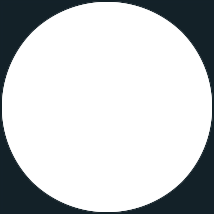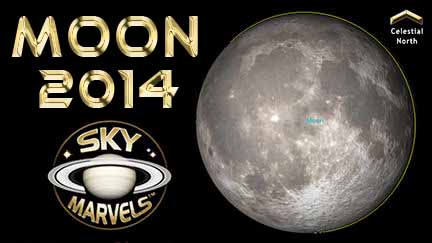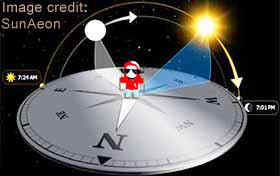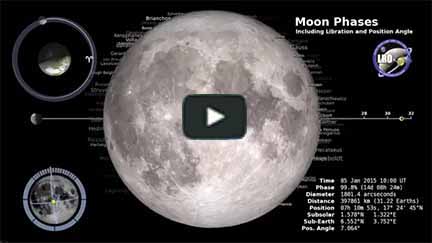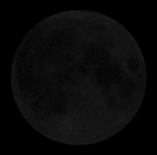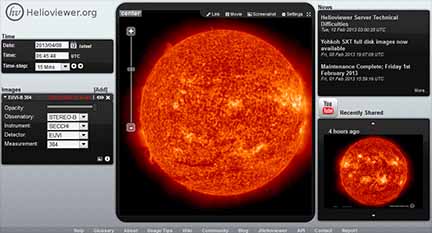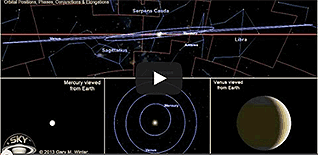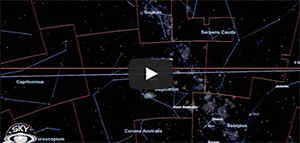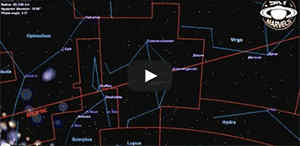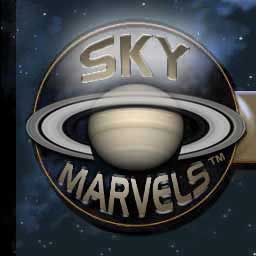









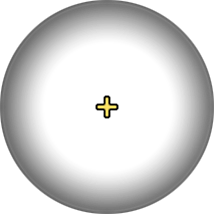
Sun's Position Over Earth
(to update, reload page)
Courtesy:
Fourmilab Switzerland
Day & Night on Earth
View Earth's Night Half
Sunrise & Sunset on Earth
Six Current Views of Earth
Current Global Cloud-Cover
Current Global Weather
Current Planet Locations
Donate safely with: PayPal
to receive one or more
Sky-Gifts. Your support is greatly appreciated!
UPCOMING
Comets:
Visible in N Hemisphere
Visible in S Hemisphere
Eclipses:
NASA:
Lunar: 2017 Feb 11
Solar: 2017 Feb 26
GIF Map only
Animation only
5 Millenia: Solar Lunar
HMNAO:
Lunar: 2017 Feb 11
Solar: 2017 Feb 26
600 Years of Eclipses
Meteor Showers:
IMO 2016 Calendar
AMS 2016 Calendar
Satellite Launches:
Transits:
SKY VIEWING
SOLAR SYSTEM
THE SUN
MERCURY
VENUS
EARTH
THE MOON
MARS
JUPITER
SATURN
URANUS
NEPTUNE
SMALLER WORLDS
STELLAR OBJECTS
EXOPLANETS
DEEP-SKY OBJECTS
SCALE OF THE COSMOS
———————
SKY-FUN / SKY-GAMES
USEFUL ASTRONOMY WEBTOOLS
USNO:
Julian Date Converter
Sun/Moon Data, 1 Day
Sun/Moon Rise/Set, 1Yr
Astronomical Lexicons:
NASA / JPL:
Basics of Space Flight
DAWN Dictionary
HubbleSite Ref. Desk
Imagine the Universe!
NED (quite extensive)
ESA:
Science Glossary
Space Science
List of Constellations (with pronunciations):
EXCITING NEW SCRIPTS COMING SOON!
Moon-Pak 1 and Planet-Pak 1 will soon bring the Moon and the planets to CELESTIA users in ways they've never seen before! And the Paks are "awesome"! Keep an eye out for them!
LUNAR APOGEES & PERIGEES
Lunar apogees & perigees show just how irregular the lunar orbit is. From 1500 to 2500 CE, the Moon's apogee averages about 405,400 km, varying from about 404,050 km to its extreme maximum of about 406,720 km. The lunar perigee is much more variable however, averaging close to 363,400 km while varying from about 370,350 km to its extreme minimum of about 356,370 km!
Extreme lunar apogees and perigees are caused mostly by the Sun's gravitational pull on the Moon, and they tend to happen in the winter months of the Northern Hemisphere. This is when Earth is near perihelion, i.e. closest (yes, closest!) to the Sun. Extreme apogees tend to happen when the Moon is New, since the Sun pulls it "away from" Earth. Extreme perigees in contrast tend to occur when the Moon is Full, as the Sun pulls it "toward" Earth. Forecasting these extremes can be important due to the Moon's influence on Earth's tides.
UTC: CELESTIA'S DISPLAY OF TIME
CELESTIA's clock displays Coordinated Universal Time, UTC. Click here for a brief explanation.
EARTH AT PERIHELION
When is Earth at perihelion, the point in its orbit closest to the Sun? Contrary to popular belief, this happens in the Northern Hemisphere's winter NOT summer! The winter season is not caused by Earth being farthest from the Sun, but rather by Earth's changing tilt in its orbit relative to the Sun!
In contemporary times Earth generally passes through perihelion between January 1 and January 6. In 2014, it occured on January 4 at 12 hour UT (Universal Time).
HIGHLIGHTS OF SOME
PAST SKY EVENTS
 Perseid Meteor Shower 2013 Aug
Perseid Meteor Shower 2013 Aug
 Geminid Meteor Shower 2012 Dec
Geminid Meteor Shower 2012 Dec
 Geminid Meteor Shower 2010 Dec
Geminid Meteor Shower 2010 Dec
 Perseid Meteor Shower 2010 Aug
Perseid Meteor Shower 2010 Aug
 Partial Lunar Eclipse 2010 Jun
Partial Lunar Eclipse 2010 Jun
Comet ISON 2013-2014:
ISON's Journey in 3-D! (Requ. WebGL browser)
Download a Paper Model of ISON's Orbit
SOME OLD-FORMAT MONTHLY NEWS PAGES
Though they feature events over a year old, here are our old-format monthly NEWS pages that you might enjoy.
2010:
Jan
Feb
Mar
Apr
May
Jun
Jul
Aug
Sep
Oct
Nov
Dec
2011:
Jan
Feb
Mar
Apr
May
Jun
Sky Events 2013 page.
Sky Events 2014 page.
Sky Events 2015 page.
NEW "SKY-GIFTS" PAGE!
Check out our exciting new Sky-Gifts page to learn how you may obtain beautiful downloadable high-resolution astronomy posters and more! They make wonderful gifts for the holidays or birthdays!
SNEAK PREVIEW!
That's what the Total Solar Eclipse of 21 August 2017 is being called. On that Monday the Moon's shadow will whisk across the United States, gracing it with a sky marvel you won't want to miss! NASA Page PDF Map SDO Event Page HMNAO Page HMNAO Visibility Tool
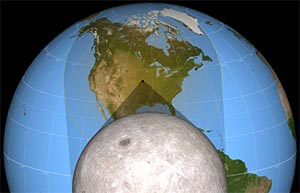
Awesome animations from NASA Goddard's SVS:
Path: (webm)
(mp4)
Visibility: (webm)
(mp4) ![]()
Eclipse Cone: (webm)
(mp4)
![]()
Orbit: (webm)
(mp4)
Oblique (webm)
(mp4)
![]()
SKY EVENTS 2016
You might want to start with Tonight's Sky Maps and the USNO's The Sky This Week. In addition, check out today's Sunrise, Sunset, Moonrise, Moonset!
Moon Phases: ![]()
![]()
![]()
![]() Today's
Today's
Calendars: This Month's This Year's
List: This Year's
MOON PHASES 2016
video credit: NASA's Scientific Visualization Studio
NOTES:
 New Moons essentially rise and set with the Sun and reflect no sunlight toward Earth, so they allow Deep Sky Observing all night.
New Moons essentially rise and set with the Sun and reflect no sunlight toward Earth, so they allow Deep Sky Observing all night. 1st Qtr Moons generally rise near "local noon" and set near "local midnight", allowing Deep Sky Observing only during the last half of the night.
1st Qtr Moons generally rise near "local noon" and set near "local midnight", allowing Deep Sky Observing only during the last half of the night. Full Moons generally rise near sunset and set near sunrise, allowing no Deep Sky Observing all night.
Full Moons generally rise near sunset and set near sunrise, allowing no Deep Sky Observing all night. Last Qtr Moons generally rise near "local midnight" and set near "local noon", allowing Deep Sky Observing only during the first half of the night.
Last Qtr Moons generally rise near "local midnight" and set near "local noon", allowing Deep Sky Observing only during the first half of the night.
2016's Eclipse "Seasons":
early thru late Mar; mid Aug thru mid Sep
CURRENT YEAR'S GREATEST ELONGATIONS
Mercury
Venus
NEXT TRANSITS: MERCURY & VENUS
Mercury: 2019 Nov 11
Venus 2117 Dec 10-11
THIS MONTH'S SKY MARVELS
Every month, HubbleSite and the Space Telescope Science Institute's Office of Public Outreach release an excellent video that highlights "sky happenings" for that month. Here is the link to the site where you may view and/or download the video for the current month.
Detailed NASA / JPL SPACE CALENDAR
This includes a lot of info on the major planets, dwarf planets, asteroids, KBO's, comets, eclipses, the Moon's occultations and more.
THE MOON
Moon's Current Distance, Apparent Size and Phase
Moon's Current Location in its Phase Cycle
View the Moon's Features that are visible from Earth with binoculars or a low-power telescope.
To help you with you lunar observations, download these classic maps of the Moon:
USAF Lunar Earthside Hemisphere Map:
Download (hi-res JP2) View Now (smaller version)
NASA Apollo-Era Lunar Chart:
Download (hi-res JP2) View Now (smaller version)
Here is a great Calendar of 2016's Moon Phases & Events courtesy of Newcastle Observatory.
Newcastle's Previous Moon Phase Calendars:
2015
2014
2013
2012
2011
2010
2009
2008
Old Format Previous Months' Phase Calendars:
2014:
Jan
2013:
Dec
Nov
Oct
Sep
Aug
Jul
Jun
May
Apr
Mar
Feb
CURRENT AURORA FORCASTS
OVATION Forecast:
Northern Lights: Aurora Borealis
Southern Lights: Aurora Australis
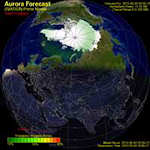
Image credit: NOAA / NWS Space Weather Prediction Center
 EARTH'S CURRENT TILT
EARTH'S CURRENT TILT
RELATIVE TO THE SUN
Though its two principal views display Earth rotating at different speeds, this Flash tool (in Dutch) lets you Easily Find Earth's Current Tilt Relative to the Sun. Moreover you can change just a few Settings to view how Earth's varying tilt throughout the year causes the seasons and affects the lengths of our days and nights. Changing the month is most instructive. (Note: in this animation the Vernal Equinox is essentially toward the bottom of your screen in its Northern Hemisphere view and outward toward you in its Oblique view.)
EQUINOXES & SOLSTICES THROUGH MARCH 2014
WHERE IS THE SUN TODAY
ALONG THE ZODIAC?
Here's a nice interactive Flash demo showing the Sun's Location Along the Zodiac at Various Times of Year. Drag its red pointer right and left over the names of the months. You can also drag the Zodiac itself.
HOW FAR NORTH OR SOUTH WILL
THE SUN RISE AND SET TODAY?
Here's a nice interactive Flash demo showing the How Far North and South the Sun Rises and Sets at Various Times of Year.
LATEST MAJOR SOLAR ACTIVITY
VISIBLE FROM EARTH
Sunspots Prominences, Flares, etc.
 W A R N I N G ! It is never safe to look directly at the real Sun with the naked eye! Moreover, looking at it through a telescope or binoculars without adequate safeguards—even for an instant—can cause permanent blindness! NEVER DO IT! To learn how to safely "observe" the real Sun, consult the professionals at your local planetarium or observatory.
W A R N I N G ! It is never safe to look directly at the real Sun with the naked eye! Moreover, looking at it through a telescope or binoculars without adequate safeguards—even for an instant—can cause permanent blindness! NEVER DO IT! To learn how to safely "observe" the real Sun, consult the professionals at your local planetarium or observatory.
GET THE LATEST AWESOME SATELLITE
VIEWS OF THE SUN WITH "HELIOVIEWER"
HelioViewer might just be the best free solar astronomy tool on the web, giving you access to countless actual photos of the Sun from multiple satellites! "Time-step" through photos, and save and even make movies of what you find! This free web-tool is not to be missed.
Here's an example movie that SkyMarvels made using HelioViewer. It shows some incredible solar prominence activity on New Year's Eve and New Year's Day!
And to help get you started, here's the direct link to the HelioViewer User Guide.
 W A R N I N G ! It is never safe to look directly at the real Sun with the naked eye! Moreover, looking at it through a telescope or binoculars without adequate safeguards—even for an instant—can cause permanent blindness! NEVER DO IT! To learn how to safely "observe" the real Sun, consult the professionals at your local planetarium or observatory.
W A R N I N G ! It is never safe to look directly at the real Sun with the naked eye! Moreover, looking at it through a telescope or binoculars without adequate safeguards—even for an instant—can cause permanent blindness! NEVER DO IT! To learn how to safely "observe" the real Sun, consult the professionals at your local planetarium or observatory.
CURRENT SUN AND MAJOR PLANET
VIEWS AND CONDITIONS FROM EARTH
Distances, Apparent Sizes, Phases, Moon Locations
Sun
Mercury
Venus
Mars
Jupiter
Saturn
Uranus
Neptune
Locations Among the Constellations (w/ Geo-Coords)
Sun
Mercury
Venus
Mars
Jupiter
Saturn
Uranus
Neptune
SOLAR SYSTEM VISUALIZATIONS
Note that the next three visualizations are oriented differently from each other. So the Vernal Equinox is in a different direction in each.
Current Locations of the Planets in their Orbits This SkyMarvels™ visualization shows the Vernal Equinox to the right, i.e. in the 3 o'clock direction.
The Solar System in 3-D This third-party visualization "opens" with the Vernal Equinox "obliquely upward", i.e. essentially in the 12 o'clock midnight direction.
Solar System Orrery This third-party visualization shows the Vernal Equinox to the left, i.e. in the 9 o'clock direction.
MERCURY'S & VENUS'S SKY PATHS 2013–2014
MERCURY MESSENGER status (completed mission with impact on Mercury as expected 2015 Apr 30)
View NASA's awesome Mars Exploration site.
MARS SPIRIT and OPPORTUNITY Locations
CLIMATIC VS. ASTRONOMICAL SEASONS
Most school children know that the climatic seasons of the two hemispheres are the reverse of each other's. For example, when it is Summer in the Northern Hemisphere, climatically-speaking it is Winter in the Southern Hemisphere.
Nonetheless the "astronomical" seasons, as well as their respective equinoxes and solstices, have always traditionally been named for the "climatic" seasons of the Northern Hemisphere—no doubt because roughly 90% of the human population lives north of Earth's equator! So the Summer Solstice, for instance, is the solstice in June at the beginning of the Northern Hemisphere's summer, etc.
Unfortunately, this traditional naming convention does create a potential ambiguity. For example, for Southern Hemisphere astronomers the "traditional" Summer Solstice occurs at the start of their climatic Winter!
This is why we often now see the less traditional (though slightly less recognizable) terms: March Equinox, June Solstice, September Equinox and December Solstice. Because these terms are more precise, they are increasingly becoming accepted as the best ways to refer to the equinoxes and solstices.
This shows Earth's snow and ice cover through the seasons Earth's 12-Month Heartbeat
HOW LONG IS EACH SEASON?
Since their beginnings and ends are explicitly defined by the Sun's arrival at the equinoxes and the solstices in our sky, Earth's astronomical seasons have precise durations. Moreover, though the equinoxes and solstices are equally spaced at 90-degree intervals around the Celestial Sphere, the astronomical seasons are not of equal length! This is because Earth's changing velocity in its elliptical orbit makes the Sun appear to arrive a little early at parts of the Celestial Sphere, and a little late at others. The lengths of the astronomical seasons are very close to the following:
Spring: 92 3/4 days
Summer: 93 2/3 days
Autumn: 89 5/6 days
Winter: 89 days.
HALF OF EARTH IN SUNLIGHT & DARKNESS
During your voyages in CELESTIA, would you like to be able to position yourself directly over the center of the half of Earth in sunlight or the half in darkness at any time this month? On our Tips page, you'll find that it's quite easy to do so! If you're any kind of sky watcher at all, you probably know just how helpful this can be!
Back to Top
Home Intro News Gallery Sky-Gifts Bonuses Tips
Learning Ctr Help Links Credits Legal Contact Us
© 2007-
by Gary M. Winter. All rights reserved.
Interested in political cartoons and humor?
Check out The HIPPLOMATS™.
GREAT AMERICAN ECLIPSE! BEST ECLIPSE IN AMERICAN HISTORY! BEST ECLIPSE IN U.S. HISTORY! BEST ECLIPSE IN US HISTORY! SkyMarvels: Your Key to the Sky and the Universe! SkyMarvels, Sky Marvels, SkyMarvels.com, SkyMarvels NEWS, SKY EVENTS NEWS, SKY NEWS, SKY EVENTS, TODAY'S LOCAL CLOUD COVER, THE SUN'S CURRENT POSITION OVER EARTH, THE MOON'S CURRENT POSITION OVER EARTH, CURRENT MOON PHASE, Current Planet Positions, Current Planet Locations, Aurora Forcast, Aurora Borealis, Northern Lights, Aurora Australis, Southern Lights, celestia4all, celestiaforall, CELESTIA, astronomy, space, simulations, animations, downloadable astronomy posters, stars, planets, Inner Planets, Outer Planets, Inferior Planets, Superior Planets, moons, asteroids, comets, Oort Cloud, galaxy, galaxies, Milky Way, Andromeda, globular clusters, binaries, quasars, black holes, supermassive black holes, telescope, telescopes, planetarium, software, freestuff, satellites, add-ons, addons, scripts, eclipses, Solar Eclipses, Lunar Eclipses, Solar Eclipse Finder, Lunar Eclipse Finder, mutual eclipses, transits, occultations, Solar System, CELES-TOOLS, celeSTARrium, CELX, CELX programming, Freebies, multiple views, atronomical unit, light year, parsec, meteors, meteor showers, Perseids, Geminids, Leonids, barycenter, time, Time Zones, tides, alignments, conjunctions, oppositions, seasons, apogees, perigees, aphelion, perihelion, Earth, Luna, Mercury, Venus, Mars, Jupiter, Galilean Moons, Io, Europa, Ganymede, Callisto, Saturn, Titan, rings, Uranus, Neptune, Triton, E-MSpectrum, electromagnetic spectrum, astronaut, equinoxes, solstices, precession, rotation, spin, inclination, tilt, Ecliptic, orbits, ellipse, parabola, hyperbola
Moon's Position Over Earth
(to update, reload page)
Courtesy: Fourmilab Switzerland
CURRENT MOON PHASE
Courtesy: USNO
(India)
ALL THE LATEST
ISS (Int'l Space Station): Current Location
USGS's LATEST
NASA's LATEST
Exoplanet Counts:
HUBBLE Space Telescope:
Observations This Week
Daily Report
News Release Archive
ISS (Int'l Space Station):
Live ISS Stream
Spot the Station
JPL News (search or scroll down)
MARS SPIRIT and OPPORTUNITY Locations
MERCURY MESSENGER status (completed mission with impact on Mercury as expected 2015 Apr 30)
NASA News (search or click on More Stories at bottom)
 W A R N I N G !
W A R N I N G !
Never look directly at the real Sun with the naked eye! It isn't safe! Moreover, looking at the Sun through a telescope or binoculars without proper safeguards, even for an instant, may cause permanent blindness! NEVER DO IT! To learn how to safely "observe" the real Sun, consult the trained professionals at your local planetarium or observatory.
SDO (SOLAR DYNAMICS OBSERVATORY)
Sun Activity: Today's Vids
Sunspots
Prominences
AIA 171 (gold)
AIA 193 (bronze)
AIA 1700 (pink)
Interactive Tool
VOYAGER 1 & 2:
ESA's LATEST
ESA News (search or scroll down)
ROSETTA:
Where Is Rosetta?
Rosetta's Journey
USNO's LATEST
OBSERVATORIES' LATEST
For the latest info from our favorite observatories, go to the Observatories Listing on our Links page.
LATEST TIDE DATA
Data from NOAA's National Ocean Service (NOS).
MISC
(requires WebGL)
For more Climate Info, check out this nice interactive tool: NASA's Eyes on the Earth. (Requires: JAVA.)
Recent and Favorite News Stories Related to Astronomy and Space
ESA News (search or scroll down)
HUBBLE News Release Archive
JPL News (search or scroll down)
NASA News (search or click on More Stories at bottom)
2016 Oct 27: Catalog of Known Near-Earth Asteroids Tops 15,000!
2015 Jan 6: Join The Hunt: Become a "Disk Detective"!
2015 Jan 6: KEPLER Logs Its 1,000th Exoplanet
2015 Jan 1: Sun Begins 2015 With Huge Coronal Hole
2014 Dec 17: ROSETTA To Fly Past Comet in February
2014 Nov 14: New Map of Small Asteroid Impacts
2014 Oct 24: NASA Finds Ice Cloud Above Titan
2014 Sep 29: CASSINI Monitoring Mysterious Markings Morphing on Major Moon
2014 Aug 12: NuSTAR Bags Black Hole Blink
2014 Jul 7: Sun Sends Tsunamis Spaceward, Says VOYAGER 1
2014 Jun 12: HERSCHEL Beholds Bout of Budding Births—of Stars, That Is
2014 May 22: WISE Findings Challenge Old Theory
2014 Apr 3: Ocean Found Inside Enceladus
2014 Mar 26: NASA Searches for Seeds of Black Holes
2014 Mar 7: WISE Finds No "Planet X"
2014 Feb 26: KEPLER Mission Announces a Planet Bonanza
2014 Feb 11: 360-Degree View of Saturn's Auroras
2014 Jan 29: Solving Mystery of Burned-Out Galaxies
2014 Jan 2: First 2014 Asteroid Discovered Slams into Earth
2013 Dec 12: Chemical Surprise Found in Crab Nebula
2013 Dec 12: Hubble Sees Evidence of Water Vapor at Jupiter Moon
2013 Dec 11: Clay-Like Minerals Found on Icy Crust of Europa
2013 Dec 10: Mars Orbiter Reveals a More Dynamic Red Planet
2013 Dec 4: CASSINI Obtains Best Views of Saturn Hexagon
2013 Dec 3: Massive Black Hole Duo: Possible Sighting by WISE
2013 Nov 21: Infant Galaxies Merge Near 'Cosmic Dawn'
2013 Nov 11: SPITZER and ALMA Reveal a Star's Bubbly Birth
2013 Oct 17: Rover Confirms Martian Meteorite Origins
2013 Sep 30: CASSINI Says Saturn's Satellite Sports Space Plastic!
2013 Sep 10: SPITZER Exposes Asteroid's Secret!
2013 Sep 5: NuSTAR "Nabs" Its First 10 Supermassive Black Holes!
2013 Aug 28: SDO Surveys Circulation Inside Sun
2013 Aug 23: 2013 Sea-Ice Retreat Unlikely to Break Record
2013 Aug 15: CURIOSITY's Movie of Passing Martian Moons
2013 Aug 15: Asteroid's Radar Images
2013 Aug 1: Does Age Quell Appetites of Gargantuan Galaxies?
2013 Jul 16: Comet ISON's Potentially Perilous Solar Encounter
2013 Jul 15: HUBBLE Finds 14th Neptunian Moon
2013 Jul 8: Radio Bursts Discovered From Beyond our Galaxy
2013 Jun 24: 10,000th NEO Discovered, Oh My!
2013 Jun 11: HERSCHEL Goggles Gobs of Galactic Gas
2013 Jun 11: NUSTAR Should Spill Slumbering Structure's Secrets
2013 Jun 6: Small Asteroid Slips Safely Between Earth and Moon
2013 May 29: WISE Looks for Lost Lineages of Asteroids
2013 May 23: Galaxy Feeding Frenzy: Frigid Fuel Found to Follow Filaments
2013 May 15: Cameras Count Crater-Causing Concussions that Scar Mars
2013 May 7: HERSCHEL Hones In on Hungry Black Hole
2013 Apr 3: Stellar Confetti in the SMC?
2013 Mar 18: CHANDRA Views Supernova Remnants Discovered by Johannes Kepler in 1604
2013 Mar 11: WISE Discovers Closest Stars Found in a Century!













